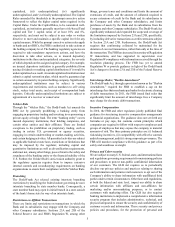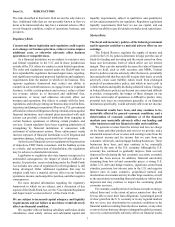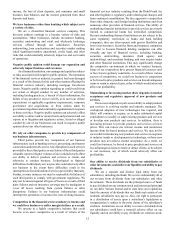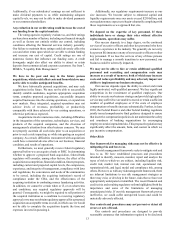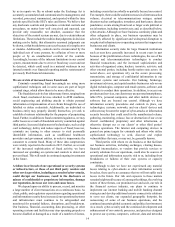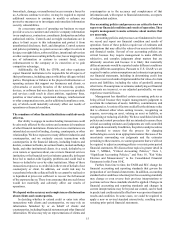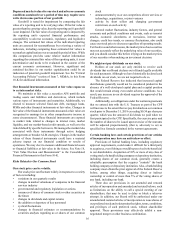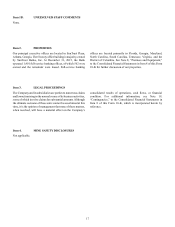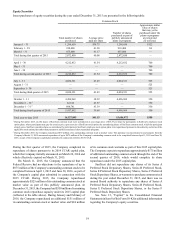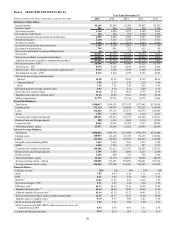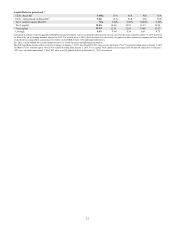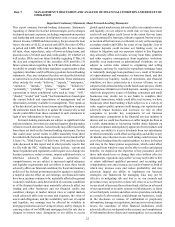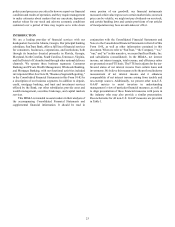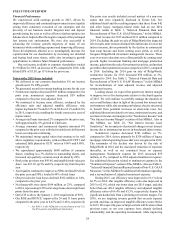SunTrust 2015 Annual Report Download - page 43
Download and view the complete annual report
Please find page 43 of the 2015 SunTrust annual report below. You can navigate through the pages in the report by either clicking on the pages listed below, or by using the keyword search tool below to find specific information within the annual report.15
from attack, damage, or unauthorized access remain a focus for
us. As threats continue to evolve, we may be required to expend
additional resources to continue to modify or enhance our
protective measures or to investigate and remediate information
security vulnerabilities.
As a necessary aspect of operating our business we must
provide access to customer and sensitive company information
to our employees, contractors, consultants, third parties and other
authorized entities. Controls and oversight mechanisms are in
place to limit access to this information and protect it from
unauthorized disclosure, theft, and disruption. Control systems
and policies pertaining to system access are subject to errors in
design, oversight failure, software failure, intentional subversion
or other compromise resulting in theft, error, loss or inappropriate
use of information or systems to commit fraud, cause
embarrassment to the company or its executives or to gain
competitive advantage.
Additionally, the FRB, the CFPB, and other regulators
expect financial institutions to be responsible for all aspects of
their performance, including aspects which they delegate to third
parties. Disruptions or failures in the physical infrastructure or
operating systems that support our businesses and clients, or
cyber-attacks or security breaches of the networks, systems,
devices, or software that our clients use to access our products
and services could result in client attrition, regulatory fines,
penalties or intervention, reputational damage, reimbursement
or other compensation costs, and/or additional compliance costs,
any of which could materially adversely affect our results of
operations or financial condition.
The soundness of other financial institutions could adversely
affect us.
Our ability to engage in routine funding transactions could
be adversely affected by the actions and commercial soundness
of other financial institutions. Financial services institutions are
interrelated as a result of trading, clearing, counterparty, or other
relationships. We have exposure to many different industries and
counterparties, and we routinely execute transactions with
counterparties in the financial industry, including brokers and
dealers, commercial banks, investment banks, mutual and hedge
funds, and other institutional clients. As a result, defaults by, or
even rumors or questions about, one or more financial services
institution, or the financial services industry generally, in the past
have led to market-wide liquidity problems and could lead to
losses or defaults by us or by other institutions. Many of these
transactions expose us to credit risk in the event of default of our
counterparty or client. In addition, our credit risk may be
exacerbated when the collateral held by us cannot be realized or
is liquidated at prices not sufficient to recover the full amount
of the exposure due us. There is no assurance that any such losses
would not materially and adversely affect our results of
operations.
We depend on the accuracy and completeness of information
about clients and counterparties.
In deciding whether to extend credit or enter into other
transactions with clients and counterparties, we may rely on
information furnished by or on behalf of clients and
counterparties, including financial statements and other financial
information. We also may rely on representations of clients and
counterparties as to the accuracy and completeness of that
information and, with respect to financial statements, on reports
of independent auditors.
Our accounting policies and processes are critical to how we
report our financial condition and results of operation. They
require management to make estimates about matters that
are uncertain.
Accounting policies and processes are fundamental to how
we record and report our financial condition and results of
operation. Some of these policies require use of estimates and
assumptions that may affect the value of our assets or liabilities
and financial results. Several of our accounting policies are
critical because they require management to make difficult,
subjective, and complex judgments about matters that are
inherently uncertain and because it is likely that materially
different amounts would be reported under different conditions
or using different assumptions. Pursuant to U.S. GAAP, we are
required to make certain assumptions and estimates in preparing
our financial statements, including in determining credit loss
reserves, reserves related to litigation and the fair value of certain
assets and liabilities, including the value of goodwill, among
other items. If assumptions or estimates underlying our financial
statements are incorrect, or are adjusted periodically, we may
experience material losses.
Management has identified certain accounting policies as
being critical because they require management's judgment to
ascertain the valuations of assets, liabilities, commitments, and
contingencies. A variety of factors could affect the ultimate value
that is obtained either when earning income, recognizing an
expense, recovering an asset, valuing an asset or liability, or
recognizing or reducing a liability. We have established detailed
policies and control procedures that are intended to ensure these
critical accounting estimates and judgments are well controlled
and applied consistently. In addition, the policies and procedures
are intended to ensure that the process for changing
methodologies occurs in an appropriate manner. Because of the
uncertainty surrounding our judgments and the estimates
pertaining to these matters, we cannot guarantee that we will not
be required to adjust accounting policies or restate prior period
financial statements. We discuss these topics in greater detail in
Item 7, MD&A, "Critical Accounting Policies,” Note 1,
“Significant Accounting Policies,” and Note 18, "Fair Value
Election and Measurement," to the Consolidated Financial
Statements in this Form 10-K.
Further, from time to time, the FASB and SEC change the
financial accounting and reporting standards that govern the
preparation of our financial statements. In addition, accounting
standard setters and those who interpret the accounting standards
may change or even reverse their previous interpretations or
positions on how these standards should be applied. Changes in
financial accounting and reporting standards and changes in
current interpretations may be beyond our control, can be hard
to predict and could materially affect how we report our financial
results and condition. In some cases, we could be required to
apply a new or revised standard retroactively, resulting in us
restating prior period financial statements.


